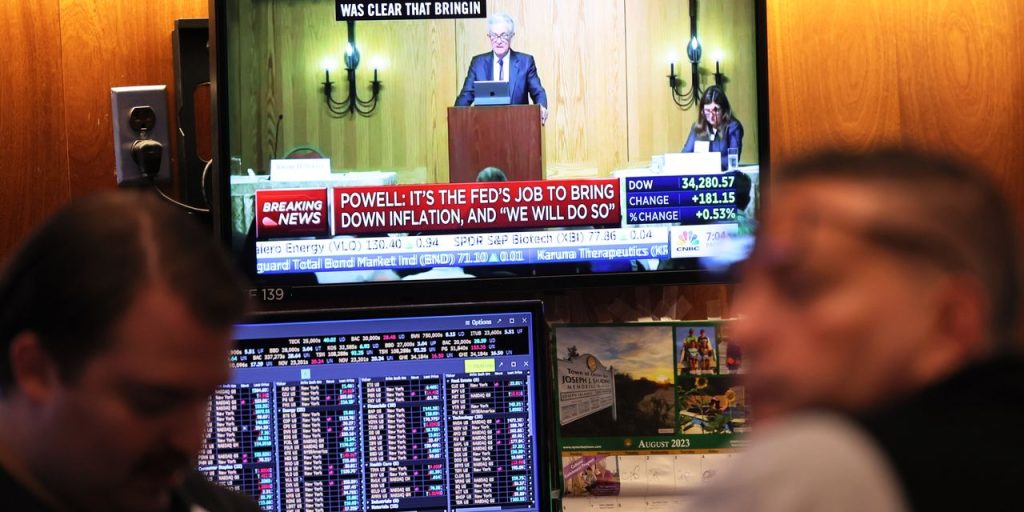The Federal Reserve’s moves — or lack thereof — will affect everyone. And almost no one.
The Fed made no rate changes on Wednesday, holding back on at least one more hike before year’s end. There are plenty of experts who believe the central bank will then let rates sit until it turns around and starts to cut rates late in 2024.
MarketWatch Live: Fed leaves interest-rate target unchanged and signals fewer rate hikes on 2023–24 horizon
While there are variations on that theme, nothing is really going to move individual investors.
Yes, Fed decisions move markets, but the typical investor is going to do nothing. And that’s the right move.
If you’re paying the fees to own an actively managed mutual fund or ETF — and especially if your investment is built to be “tactical” — you hope that the pros are reacting appropriately to the monetary-policy action.
But if you have ridden with your portfolio for this long and haven’t made a move yet — haven’t started tilting toward small-cap or bank stocks or some unloved portion of the market, or heading for high ground in bonds as an income-producing safe harbor — nothing Fed Chair Jerome Powell says is going to move you.
The bigger question is what might move you, and whether anything we hear from the Fed should spur you to do something.
Disagreement makes a market, and you can find plenty of it in today’s market. There’s the no-landing camp and the hard-landing believers, the people telling the tale of exhausted and overspent consumers facing high inflation, and the experts talking about rising levels of income and persistently low levels of unemployment.
The problem is that any long-term individual investor who reacts to current Fed news is worrying about the wrong disagreements and considering the wrong questions.
The many experts forecasting soft- or no-landing scenarios aren’t suggesting that the economy can avoid a downturn and stave off recession forever; they’re mostly saying that the end and eventual bottom to the current economic cycle is being pushed back.
Moreover, whenever the cycle reaches its end, “hard” and “soft” are the wrong adjectives to worry about. “Long or short?” is the question individuals will wrestle with.
It’s way too early to react to the idea that there could be a big downturn after the 2024 presidential election — and regardless of who wins — beginning in 2025.
It’s never too early to consider whether your investment portfolio will be properly positioned for your time in life when that happens.
Now in my 60s — though I have no intention of retiring soon — my biggest personal worry has long been “sequence-of-return risk,” where an individual investor retires into a market downturn, and the impact of a market decline combined with the first few years of pulling assets out of retirement accounts diminishes a portfolio in ways that last for the rest of that saver’s lifetime.
The more any future “landing” gets pushed out into the future, the more potential it has to impact my lifetime savings if that eventual touchdown occurs at just the wrong time.
That timing is highly individual and personal. A younger investor in an accumulation phase of life can much more easily ride out downturns and make them long-term buying opportunities, even if the country faces a long-lasting hard landing. By comparison, someone who retired during the COVID pandemic has spent the first three years in retirement with the market posting a 12% annualized average gain, enough to start their retirement securely and beat back most of the damaging potential of sequence-of-return risk (assuming they amassed a sufficient retirement nest egg).
Look at the markets personally: If you consider what the Fed’s moves actually mean to your long-term finances, the overwhelming conclusion should be “nothing.” If that isn’t the answer, then you are in the small percentage of people who might be right in making changes now, not because of what the Fed does now but because your portfolio is not properly aligned with your future needs.
Roni Israelov, president and chief investment officer at NDVR, a firm that constructs portfolios, says the current news feed shouldn’t move anyone.
Moreover, he cautioned against recency bias — letting events that are lingering on the brain have too much influence. He noted that stocks and bonds have had a long-term negative correlation — making them ideal portfolio diversifiers — despite moving in lockstep in 2022, giving investors a double whammy of a downturn.
Yes, that could happen again, but the storm the equity and fixed-income markets faced in 2022 is very different from the dark clouds on the horizon today.
Yet it’s easy to get caught up in the idea that diversification, in any given year, can look like a failure, but that it tends to be genius over a lifetime.
“Begin with the goals and use that to guide the asset allocation,” Israelov said in a recent interview on my podcast, “Money Life with Chuck Jaffe.” “We start the conversation [with goals]. … Is the goal to meet a certain income stream in retirement, is the goal to accumulate wealth, is the goal to pass on a legacy to the next generation? … Build to the goals.”
So go ahead and worry about it — we should all be concerned with the state of the economy, the high prices we are paying and the prospects for the future — but don’t confuse it for “news you can use.”
It’s your asset allocation — and the emotional discipline to stick with it — rather than anything the Fed does that will determine your long-term financial success.
Read the full article here















